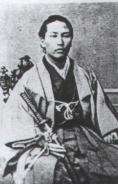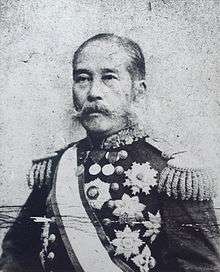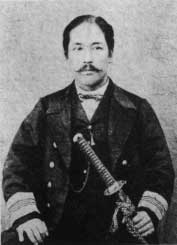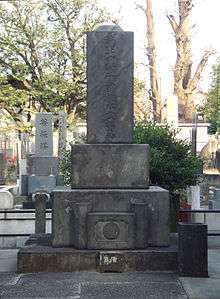Enomoto Takeaki
| Enomoto Takeaki 榎本 武揚 | |
|---|---|
|
Enomoto Takeaki in Ezo, aged 32 (1868-1869) | |
| President of Republic of Ezo | |
|
In office 27 January 1869 – 27 June 1869 | |
| Vice President | Matsudaira Taro |
| Preceded by | Position established |
| Succeeded by | Position abolished |
| Personal details | |
| Born |
5 October 1836 Edo, Japan |
| Died |
26 October 1908 (aged 72) Tokyo, Japan |
| Political party | Independent |
| Military service | |
| Allegiance |
|
| Service/branch |
|
| Years of service | 1874–1908 |
| Rank |
|
| Battles/wars |
Boshin War Battle of Hakodate Naval Battle of Hakodate Bay |
Viscount Enomoto Takeaki (榎本 武揚, 5 October 1836 – 26 October 1908) was a samurai and admiral of the Tokugawa navy of Bakumatsu-period Japan, who remained faithful to the Tokugawa shogunate and fought against the new Meiji government until the end of the Boshin War. He later served in the Meiji government as one of the founders of the Imperial Japanese Navy.
Biography
Early life

Enomoto was born as a member of a samurai family in the direct service of the Tokugawa clan in the Shitaya district of Edo (modern Taitō, Tokyo). Enomoto started learning Dutch in the 1850s, and after Japan's forced "opening" by Commodore Matthew Perry in 1854, he studied at the Tokugawa shogunate's Naval Training Center in Nagasaki and at the Tsukiji Warship Training Center in Edo.
At the age of 26, Enomoto was sent to the Netherlands to study western techniques in naval warfare and to procure western technologies. He stayed in Europe from 1862 to 1867, and became fluent in both the Dutch and English languages.[1]
Enomoto returned to Japan on board the Kaiyō Maru, a steam warship purchased from the Netherlands by the Shogunal government. During his stay in Europe, Enomoto had realized that the telegraph would be an important means of communication in the future, and started planning a system to connect Edo and Yokohama. Upon his return, Enomoto was promoted to Kaigun Fukusosai (海軍副総裁), the second highest rank in the Tokugawa Navy, at the age of 31. He also received the court title of Izumi-no-kami (和泉守).
Boshin War and Meiji Restoration

During the Meiji Restoration, after the surrender of Edo in 1868 during the Boshin War to forces loyal to the Satchō Alliance, Enomoto refused to deliver up his warships, and escaped to Hakodate in Hokkaido with the remainder of the Tokugawa Navy and a handful of French military advisers and their leader Jules Brunet. His fleet of eight steam warships was the strongest in Japan at the time.
Enomoto hoped to create an independent country under the rule of the Tokugawa family in Hokkaidō, but the Meiji government refused to accept partition of Japan. On 27 January 1869, the Tokugawa loyalists declared the foundation of the Republic of Ezo and elected Enomoto as president.
The Meiji government forces invaded Hokkaidō and defeated Enomoto's forces in the Naval Battle of Hakodate. On 27 June 1869, the Republic of Ezo collapsed, and Hokkaidō came under the rule of the central government headed by the Meiji Emperor.
As a Meiji politician

After his surrender, Enomoto was arrested, accused of high treason and imprisoned. However, the leaders of the new Meiji government (largely at the insistence of Kuroda Kiyotaka) pardoned Enomoto in 1872, realizing that his various talents and accumulated knowledge could be of use. Enomoto became one of the few former Tokugawa loyalists who made the transition to the new ruling elite, as politics at the time was dominated by men from Chōshū and Satsuma, who had a strong bias against outsiders in general, and former Tokugawa retainers in particular. However, Enomoto was an exception, and rose quickly within the new ruling clique, to a higher status than any other member of the former Tokugawa government.
In 1874, Enomoto was given the rank of vice-admiral in the fledgling Imperial Japanese Navy. The following year, he was sent to Russia as a special envoy to negotiate the Treaty of St. Petersburg. The successful conclusion of the treaty was very well received in Japan and further raised Enomoto's prestige within the ruling circles, and the fact that Enomoto had been chosen for such an important mission was seen as evidence of reconciliation between former foes in the government.[2]
In 1880, Enomoto became Navy Minister (海軍卿). In 1885, his diplomatic skills were again called upon to assisting Itō Hirobumi in concluding the Convention of Tientsin with Qing China. Afterwards, Enomoto held a series of high posts in the Japanese government. He was Japan's first Minister of Communications (1885–1888) after the introduction of the cabinet system in 1885. He was also Minister of Agriculture and Commerce from 1894–1897, Minister of Education from 1889–1890 and Foreign Minister from 1891-1892.[3]
In 1887, Enomoto was ennobled the rank of viscount under the kazoku peerage system, and was selected as a member of the Privy Council.
Enomoto was especially active in promoting Japanese emigration through settler colonies in the Pacific Ocean and South and Central America. In 1891, he established — against the will of the cabinet of Matsukata Masayoshi — a "section for emigration" in the Foreign Ministry, with the task of encouraging emigration and finding new potential territories for Japanese settlement overseas. Two years later, after leaving the government, Enomoto also helped to establish a private organization, the "Colonial Association", to promote external trade and emigration.
Enomoto died in 1908 at the age of 72. His grave is at the temple of Kisshō-ji, Bunkyo-ku, Tokyo.[4] (35°43′39″N 139°45′13″E / 35.727425°N 139.75364°E)
Honours
 Grand Cordon of the Order of the Rising Sun (1886)
Grand Cordon of the Order of the Rising Sun (1886) Grand Cordon of the Order of the Paulownia Flowers (1908)
Grand Cordon of the Order of the Paulownia Flowers (1908)
See also
Notes
References
- Kamo, Giichi. Enomoto Takeaki. Chuo Koronsha ISBN 4-12-201509-X (Japanese)
- Yamamoto, Atsuko. Jidai o shissoshita kokusaijin Enomoto Takeaki: Raten Amerika iju no michi o hiraku. Shinzansha (1997).ISBN 4-7972-1541-0 (Japanese)
- Akita, George. (1967) Foundations of constitutional government in modern Japan, 1868-1900. Cambridge, Harvard University Press, ISBN 978-0-8248-2560-7.
- Hane, Mikiso. Modern Japan: A Historical Survey. Westview Press (2001). ISBN 0-8133-3756-9
- Hillsborough, Romulus. Shinsengumi: The Shogun's Last Samurai Corps. Tuttle Publishing (2005). ISBN 0-8048-3627-2
- Jansen, Marius B. and John Whitney Hall, eds. (1989). The Emergence of Meiji Japan, The Cambridge History of Japan, Vol. 5. Cambridge: Cambridge University Press. ISBN 9780521482387; ISBN 9780521484053; OCLC 31515308
- Keene, Donald. (1984). Dawn to the West: Japanese Literature of the Modern Era. New York: Holt, Rinehart, and Winston. ISBN 9780030628146; ISBN 9780030628160; OCLC 8728400
- Ravina, Mark. (2004). The Last Samurai: The Life and Battles of Saigo Takamori. Hoboken, New Jersey: Wiley. ISBN 9780471089704; OCLC 427566169
| Wikimedia Commons has media related to Enomoto Takeaki. |
| Government offices | ||
|---|---|---|
| New creation | President of Ezo Jan 1869 - Jun 1869 |
Position abolished |
| Political offices | ||
| Preceded by Kawamura Sumiyoshi |
Naval Lord (Ministry of Military Affairs) Feb 1880 - Apr 1881 |
Succeeded by Kawamura Sumiyoshi |
| New creation | Minister of Communications Dec 1885 - Mar 1889 |
Succeeded by Gotō Shōjirō |
| Preceded by Ōyama Iwao |
Minister of Education Mar 1889 - May 1890 |
Succeeded by Yoshikawa Akimasa |
| Preceded by Aoki Shūzō |
Minister for Foreign Affairs May 1891 - Aug 1892 |
Succeeded by Mutsu Munemitsu |
| Preceded by Kuroda Kiyotaka |
Minister of Agriculture & Commerce Apr 1888-Jul 1888 (interim) |
Succeeded by Inoue Kaoru |
| Preceded by Gotō Shōjirō |
Ministry of Agriculture and Commerce Jan 1894 - March 1897 |
Succeeded by Ōkuma Shigenobu |

